and the distribution of digital products.
State of XRP Ledger Q2 2024
- The AMM (first launched at the end of Q1) achieved more than $23 million in volume and $8 million in total-value-locked (TVL) in the second quarter.
- Average daily transactions declined 67% QoQ from 2.8 million in Q1’24 to 0.9 million in Q2’24, a return to the mean after Q1’24 saw heightened inscription-related activity.
- A USD-pegged stablecoin was announced that will launch on both the XRPL and Ethereum, using XRPL native functionality and ERC-20 token standards, respectively.
- The Axelar bridge integration and new stablecoin can serve as liquidity catalysts for the AMM and upcoming tokenized assets from RWA projects such as Archax, which intends to bring hundreds of millions of dollars of RWAs to the XRP Ledger.
- The rippled 2.2 release in June included an amendment to introduce a price oracle to the XRPL and for pricing wrapped/bridged assets.
XRP Ledger (XRP) has been running for over a decade, offering cross-currency and cross-border payments, and tokenization, among other features. Core value propositions of the XRP Ledger (XRPL) include fast and cheap transactions (relative to other currency-focused networks) and native functionalities — such as tokens, NFTs, a decentralized exchange (DEX), escrow functionality, embedded compliance, and token management.
With these capabilities, the XRPL can execute many of the same functions as other networks. NFTs, stablecoins, synthetic assets, and other markets found on programmable settlement layers are available on the XRPL as native functionality with composability through enshrined mechanisms such as a central limit order book (CLOB) and automated market maker (AMM). The XRPL base layer doesn't currently support arbitrary smart contracts, which was a deliberate design choice to prioritize security and stability through simplicity. However, the community is actively exploring ways to introduce advanced scripting functionality, such as through solutions like Hooks. Additionally, alternative execution environments, via sidechains, add additional functionality and use cases to the overall ecosystem.
The XRPL is supported by various development groups and individuals, including Ripple, XRPL Foundation, XRPL Labs (and Xaman), and XRPL Commons. It provides a digital payment infrastructure not just for individuals but also for existing financial entities, such as commercial banks and fintechs, with the community's deep interest in B2B and B2C solutions for finance. For a full primer on XRP Ledger, refer to our Initiation of Coverage report.
Key Metrics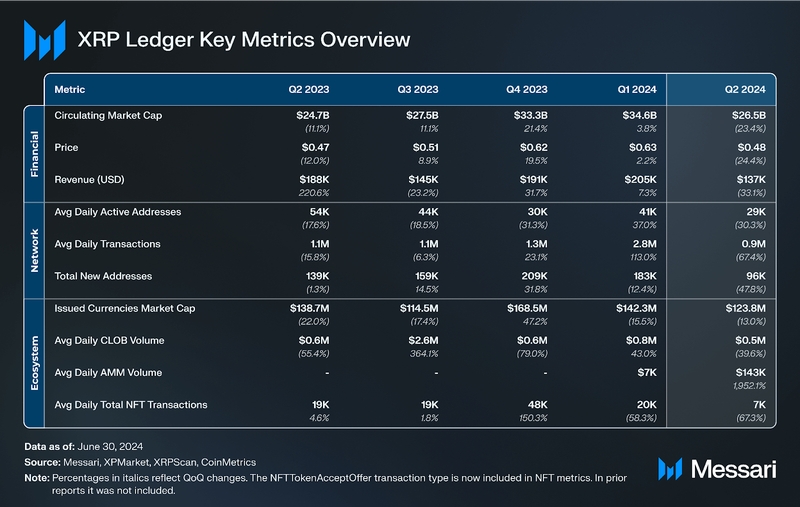 Financial Analysis
Financial Analysis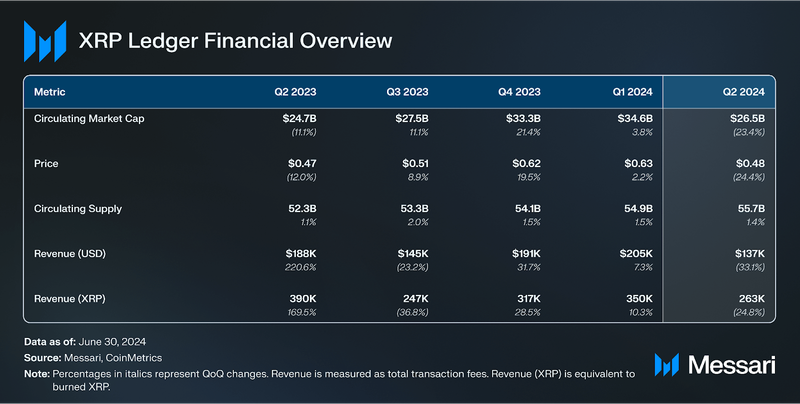
At the close of Q2’24, the XRPL’s native token, XRP, was the seventh largest cryptocurrency by market capitalization at $26.5 billion. Its circulating market cap decreased 23.4% QoQ. XRP’s price decreased 24.4% QoQ, with the discrepancy between market cap and price being due to a 1.4% increase in circulating supply.
On XRPL, transaction fees are systematically burned, applying deflationary pressure to the total supply of 100 billion XRP. Since the XRP Ledger’s inception, around 12.6 million XRP ($6 million at the close of Q2’24) has been burned. This low burn rate is due to the relatively low transaction fees (<$0.002 per transaction) on the network. Counteracting the burn rate, 1 billion XRP ($475 million at the close of Q2’24) is released from escrow to Ripple per month. Any XRP not spent or distributed by Ripple in that month is put into new escrow contracts. This system will continue until the remaining ~41 billion XRP becomes liquid. After all escrowed tokens become liquid, the deflationary pressure from burned fees will be the only variable related to supply.
Unlike many other cryptocurrency networks, the XRPL does not distribute rewards or transaction fees to its validators. In Proof-of-Association (PoA), rather than receiving rewards, validators are mainly incentivized by supporting the decentralization of the network, similar to a full node for Ethereum/Bitcoin rather than a validator/miner. The PoA consensus algorithm relies on trust between nodes, organized through unique node lists (UNLs).
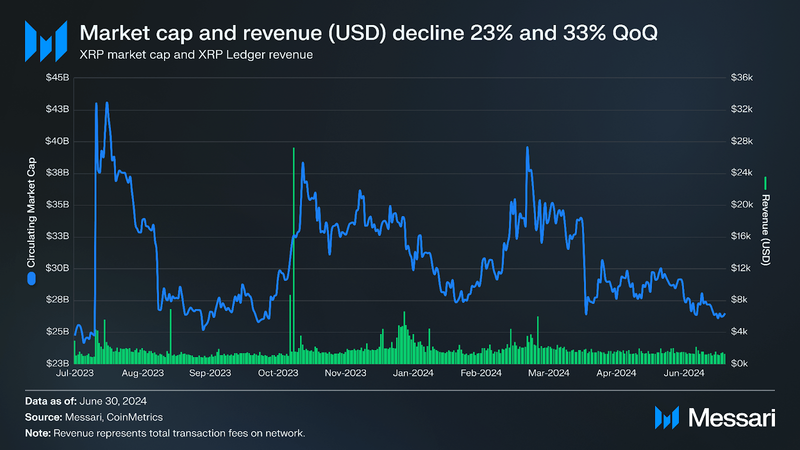
XRP’s QoQ market cap decrease of 23% outpaced the overall crypto market’s decline of 13%. On an annual scale, XRP’s circulating market cap has increased 7% YoY. Revenue is measured as total fees collected by the network. In the case of XRPL, these fees are burnt and not distributed to stakers like on many other networks. The burning of those fees still decreases the overall supply, adding value to the remaining XRP. In this way, revenue still represents a redistribution of wealth from transaction fee spenders to XRP holders.
Network Analysis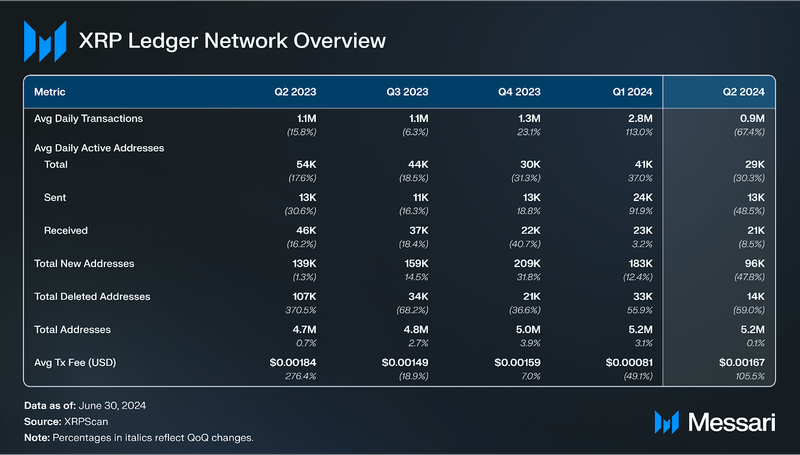
In the second consecutive quarter, all measured network metrics declined except for total addresses (+0.1% QoQ) and average transaction fee (+105% QoQ).
On its surface, this might seem remarkable. However, last quarter transaction activity was elevated due to a relatively small group of accounts sending transactions to a single account. Over 30 million transactions were sent to a single account by a group of ~45,000 accounts, for inscription-related activity. Inscriptions are a transaction type popularized on Bitcoin in early 2023 which have popped up on almost every other large network since, even causing outages from the high activity volumes. XRP Script is responsible for much of the inscription activity. Because nearly all inscription-related transactions use a base fee (10 drops), the average transaction fee in Q1 2024 was driven down to roughly half of its historical average, but returned to the mean in Q2 alongside the decline in inscription-related activity.
While the net number of accounts (total addresses) increased slightly (+0.1%) to 5.2 million in Q2, new addresses decreased 48% QoQ to 96,000. This QoQ decline is a continuation of the decline that began in Q1 due to an unusually high number of addresses created in Q4 when inscription activity began. Likewise, deleted addresses decreased by 59% QoQ to 14,000, a continuation of the trend established in Q1 of decreasing inscription activity. On an annual scale, quarterly new addresses decreased 31% from Q2 2023 to Q2 2024. Account creations and deletions are meaningful on the XRPL (unlike on most networks) as accounts require a 10 XRP deposit to be created, which can be reclaimed after deleting the account. As such, the XRPL’s account metrics are more reliable than other networks where account creations can easily be spammed/Sybiled at zero cost.
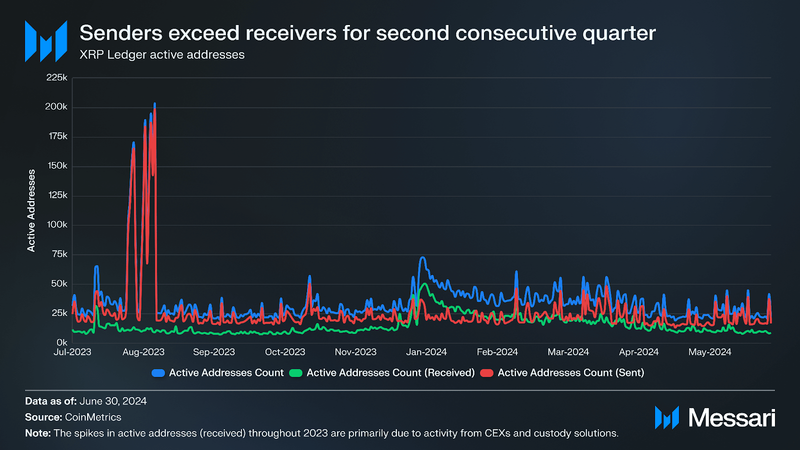
Addresses on the XRPL can contain destination tags, which enable a single address to receive and track XRP deposits for an arbitrary number of users. As a result, the number of daily active addresses is skewed downward, given that one account (e.g., a centralized exchange) could be responsible for a large number of users. It should be noted that a unique address is required for receiving tokens on most other networks, like ETH on Ethereum or BTC on Bitcoin.
The active recipient metric is determined by the number of addresses that receive a transfer or other transaction, which had been the primary factor behind major activity spikes in 2023. The 2023 metric spikes came from accounts that were recipients, not senders. This indicates that the network's activity surges were generally caused by senders distributing tokens to large groups of previously inactive recipients. Many of the senders were wallets distributing airdrops, such as XRPDrops. Airdrops are a token distribution strategy to reward and engage community members, which is more practical on networks with low transaction fees, such as the XRPL, or networks that enable batch transactions. From July 30 to August 13, the XRPL averaged 122,000 daily active addresses (received), which was 3.3x the daily average in Q3. However, this was not the case in Q1 2023.
Overall active addresses decreased 67% QoQ, primarily driven by active addresses sent (i.e., unique senders) which decreased 48% QoQ. Despite this, unique senders exceeded unique receivers for the second consecutive quarter. This occurred due to declining inscription activity still driving overall activity, with the users that created and distributed inscriptions using new accounts for each activity.
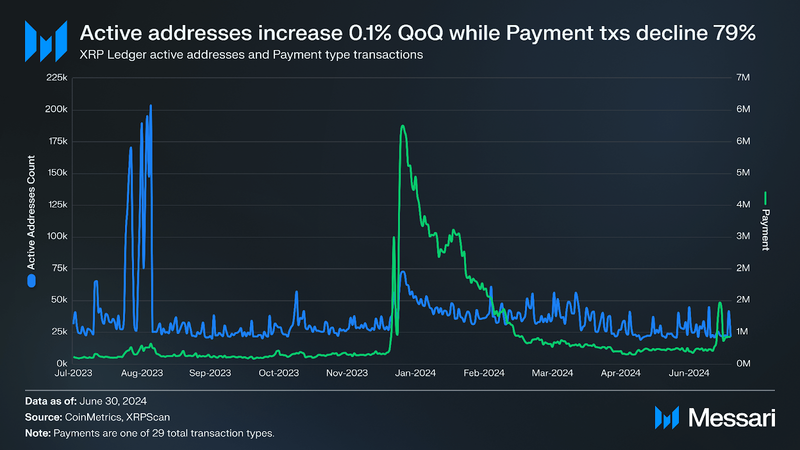
As with the other metrics discussed above, the decline in Payment transactions during Q2 was due to a decline in inscription activity after peaking in Q1 with over 22 million Payments executed over the span of one week. Historically, for the smaller activity spikes in 2023, the difference between the active recipient and sender addresses has been largely due to centralized exchanges and custodians using destination tags and sending Payment transactions. Centralized exchanges and custodians mostly use the Payment transaction type for deposits and withdrawals. As such, the Payment transaction type has consistently had more receiving addresses than sending addresses. In addition, users typically prefer creating wallets on centralized solutions for easy access to the initial XRP required to create a self-custody wallet. After acquiring their initial XRP, many users withdraw to their self-custody wallets, resulting in fewer active senders and many active receivers.

The total daily transactions metric includes 41 different transaction types, such as payments, escrow creations, NFT burns, and account deletions. Average total daily transactions decreased 67% QoQ from 2.77 million per day to 0.90 million per day.
Prior to Q1 2024, OfferCreate, a transaction type that submits an order to exchange cryptoassets, has consistently represented the bulk of transactions. This transaction type only creates an “Order” on the order book and does not necessarily facilitate an exchange unless it completes an existing open Order. OfferCreate initiates a DEX limit order, and Offer objects represent bids/asks on the order book. Offers are consumed to process transactions such as Payments and OfferCancels (triggered manually or by expirations). If an Offer is only partially consumed by a transaction, new Offers are created with the remainder of the original, similar to a UTXO. Offers can be canceled by the OfferCancel transaction. Trust Lines are structures for holding tokens that protect accounts from being sent unwanted tokens, and the TrustSet transaction is used to open or close those Trust Lines. Notably, TrustSet was the only transaction category that grew in the second quarter (+2.4%), reflecting increased adoption of issued currencies on the XRPL.

While Payments exceeded OfferCreates for the second consecutive quarter, Payments share of the overall transaction count declined 79% QoQ, reflecting the decline in inscription activity from its peak in Q1. Prior to Q1 2024, OfferCreate has historically been the most common transaction type.
Overall, average total daily transactions decreased 67% QoQ from 2.77 million per day to 0.90 million per day. The “Other” category of transactions includes functionalities for NFTs, escrows, multisigs, setting signer keys, and more. NFT transaction types were standardized and enabled by XLS-20 in October 2022, resulting in a sudden spike in transaction dominance. These transaction types are covered in depth in the Ecosystem Overview section.
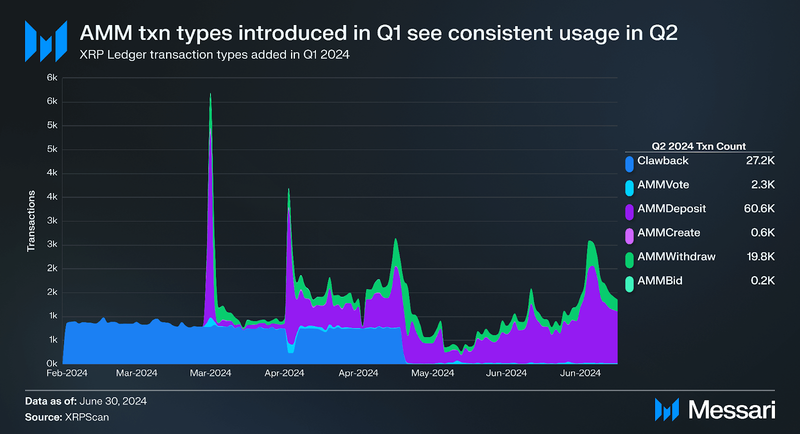
Six new transaction types were introduced in February and March of Q1 2024:
- Clawback
- AMMVote
- AMMDeposit
- AMMCreate
- AMMWithdraw
- AMMBid
Clawback transactions launched in February and saw steady usage through April, likely in part due to ecosystem developers testing integrations with it. The other five transactions types were introduced in March with the launch of the AMM. Because several functional issues were quickly uncovered, developers advised users to avoid using AMM pools until they were fixed.
On March 27, rippled V2.1.1 was released with the fixAMMOverflowOffer amendment. The bug fix amendment was activated on April 11 to address the critical bug related to handling large synthetic AMM offers within the payment engine. Following this patch, the newly introduced AMM transaction types saw sustained usage throughout the quarter.
DEXCLOB
A built-in central limit order book (CLOB) processes exchanges on the XRPL for fungible tokens (also called Issued Currencies or simply tokens). This CLOB has been part of the XRPL since inception and comes with the benefit of fewer trust assumptions and consolidated liquidity, rather than the inherent vulnerabilities of smart contracts. The majority of transactions come from the native CLOB. Although there is only one CLOB, there are many marketplaces acting as gateways that facilitate access. Gateways, also known as marketplaces, all share liquidity and provide a viable user interface for the average user.
AMM
In addition to the existing CLOB, an automated market maker (AMM) was voted into the protocol in Q1, as detailed by the XLS-30 standard. AMMs function through liquidity pools that algorithmically price assets rather than creating offers of preset specifications. Liquidity pools allow holders to earn a share of trade fees on their tokens by offering them as liquidity. Notably, orders can be partially routed through the AMM and partially through the CLOB, as both work together as part of the DEX.
ServersNodes and validators, known as servers, all run the same client software: rippled. Over 66% of nodes upgraded to V2.2.0 in June of Q2. The remaining nodes either have yet to vote or have chosen not to update in order to vote against the implemented amendments. As of the end of Q2, the XRPL is supported by 602 nodes and 119 validators. Nodes decreased from 627, and validators decreased from 124 since Q1.
XRPL servers participate in federated consensus as part of the XRPL’s Proof-of-Association (PoA) consensus mechanism. Validators do not stake tokens or receive financial rewards. Instead, the system is based on trust between nodes. Each node sets a list of trusted nodes, known as a unique node list (UNL). The UNLModify transaction, which is used to add/remove nodes from a UNL, was called an average of 3.2 times per day in Q2.
Ecosystem Analysis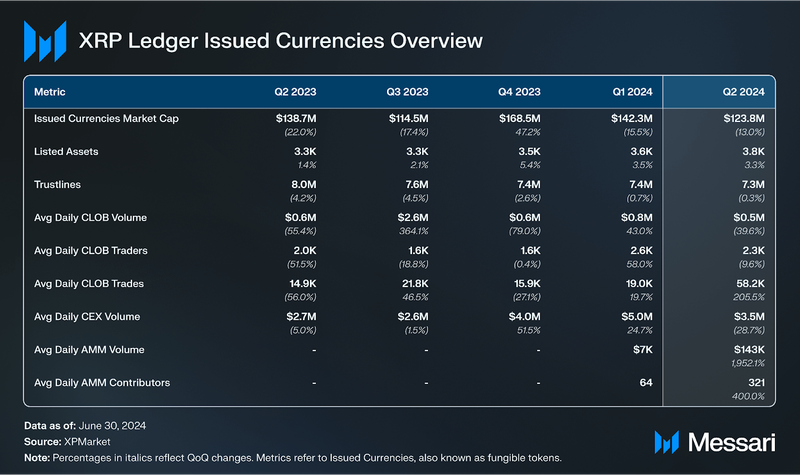
Although the XRPL’s ecosystem hosts many of the same features as programmable settlement networks — such as Ethereum, Solana, and Cardano — the XRPL does not natively support smart contracts. Arbitrary smart contracts are not enabled on the base layer as a design choice to ensure maximum security and stability. Instead, ecosystem artifacts – such as a DEX and Issued Currencies – are natively built into the protocol. The XRPL supports multiple assets through tokens (also called Issued Currencies or IOUs). They are onchain representations of arbitrary currencies, commodities, units, etc.
DeFiThe total market cap of fungible tokens, known as Issued Currencies, decreased 6% QoQ to $124 million. There are nearly 3,800 listed assets on the XRPL, but the top token, SOLO, accounted for 34% of the total market cap. Combined, the top three tokens accounted for 62% of the total market cap.
The top tokens on the XRPL by market cap at the close of Q2 were as follows:
- Sologenic (SOLO) had a market cap of $41.7 million and 228,000 holders. SOLO is primarily used to pay transaction fees on the Sologenic gateway.
- Gatehub Fifth (ETH) had a market cap of $20.5 million and 26,000 holders. Gatehub fifth is a wrapped version of Ether provided by GateHub.
- Coreum (CORE) had $14.7 million in market cap and 52,000 holders. CORE is the native token of the Coreum sidechain, which was also developed by the Sologenic team.
Trust Lines make metrics around token behavior on the XRPL more reliable. While an account’s first two trustlines are free, thereafter the XRPL requires a lockup of 2 XRP for an account to hold an Issued Currency and wallet reserves, which require a lockup of 10 XRP to create a wallet. These requirements make it expensive to enact a Sybil attack on XRPL metrics, such as the number of holders. For this reason, the number of holders is a reliable metric of a token’s adoption on the XRPL. The metric is especially relevant for fungible tokens, which have much higher supplies than NFTs.
The average daily CLOB volume of fungible Issued Currencies decreased 40% QoQ to $480,000. This came despite the average daily amount of CLOB trades increasing from 19,000 to 58,200 (+205% QoQ). Still, average daily CLOB traders declined 10% QoQ, falling from 2,600 to 2,300. Sologenic is the leading DEX (i.e., the leading gateway to the native DEX) on the XRPL by volume of Issued Currencies exchanged. Other prominent DEXs (gateways) include XPMarket and Orchestra Finance.

In contrast, AMM volume has steadily increased since the launch of the AMM in March, enough to eclipse CLOB volume for six days in June. Both incumbents, such as Sologenic and the team behind xrp.cafe, as well as new platforms, such as Orchestra Finance, and Moai Finance have integrated. Some notable features offered by these protocols include Orchestra Finance’s continuous auction mechanism for reduced trading fees and the introduction of a Telegram trading bot (First Ledger) by the team behind xrp.cafe. Liquidity on the AMM is shared across all DEXs (gateways), just like with the CLOB.
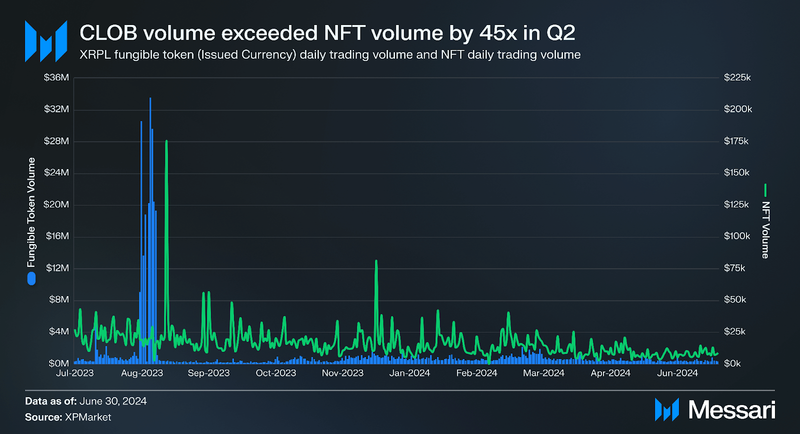
Stablecoins and wrapped tokens are popular on XRPL ranked by number of holders, relative to other tokens. Gatehub and Xaman (formerly Xumm) have worked together to offer a total of 14 digital assets on XRPL. The top stablecoins and wrapped tokens (also known as IOUs) on the XRPL at the close of Q2 were as follows:
- Gatehub Fifth (ETH): $20.5 million market cap and 26,000 holders
- Bitstamp BTC: $12.5 million market cap and 4,000 holders
- Gatehub USD: $3.6 million market cap and 20,000 holders
- Bitstamp USD: $2.0 million market cap and 7,000 holders
In April Ripple announced plans to launch a USD-pegged stablecoin, Ripple USD (RLUSD) on both the XRPL and on Ethereum, using XRPL native functionality and ERC-20 token standards, respectively. The stablecoin will be backed entirely by U.S. dollar deposits, short-term U.S. treasuries, and “other cash equivalents," with monthly third-party attestations. The introduction of a trusted stablecoin in a novel execution environment has proven to be a massive liquidity event in many cases (e.g., Cardano’s iUSD in 2023), particularly as a desired pairing asset for AMMs. Currently, stablecoins on XRPL have not seen the adoption of major stablecoins on other networks, such as USDT ($114 billion market cap) or USDC ($34 billion market cap).
Also in April, a proposal (XLS-66) was made to introduce a native lending protocol on XRPL, whereby users could lend and borrow supported assets, such as XRP, wBTC and wETH. Unlike overcollateralized lending protocols like Aave, the protocol is intended to offer onchain fixed-term and rate loans via offchain underwriting, risk management, and an insurance fund — a model akin to that implemented by TrueFi on Ethereum.
As part of the upgrade to V2.2.0 in June, an amendment was made to introduce a price oracle to the XRPL and its EVM sidechain for pricing wrapped/bridged assets, as defined in XLS-47. As of the end of the second quarter, the amendment’s source code has yet to be enabled. For an amendment’s source code to be enabled, 80.00% or more of the block-producing validators must support the amended source code for two weeks. Any validators that do not support the amended source code after this are subsequently blocked from contributing to consensus until they update to the newly changed version. Once this amendment is enabled, the oracle service Band Protocol will integrate with the XRPL and its EVM sidechain, providing greater data availability for pricing wrapped/bridged assets.
Proposal XLS-39 introduced a clawback function to help protect token issuers. This amendment, enabled in Q1 2024, enables token issuers to reclaim issued assets from holders. It was made with regulation in mind, as it gives issuers more control. With the amendment to enable the multi-purpose token standard (MPT) scheduled to be introduced in Q3, clawback will have a clear use case for issuers of RWAs. Another notable benefit of the MPT standard that is now available on Devnet is support for metadata to store parameters regarding an issued RWA, such as the maturity data of a tokenized bond.
Axelar, a full-stack interoperability protocol (i.e., a crypto overlay network), will be integrated with XRPL in Q4. It will connect the XRPL ecosystem to the 60+ networks, including the Ethereum and Cosmos ecosystems. As the AMM grows, the Axelar connection makes it easier to source liquidity from many of the highest-TVL networks.
RWAsReal-world assets (RWAs) are being made available on XRPL in several ways. In May, Tiamonds, a tokenized diamond project, whereby users can hold NFTs representing real-world diamonds launched on the xrp.cafe marketplace. Additional RWA-related developments on the XRPL include:
- Zoniqx and Ripple are working on bringing Zoniqx’s tokenization services to the XRPL. The clawback feature, currently live on XRPL mainnet, in particular allows asset issuers to experiment with moving RWAs onchain while remaining compliant.
- Meld Gold announced a partnership with Ripple to bring fungible gold and silver assets to the XRPL in Q3.
- Archax and Ripple are developing a mechanism for financial institutions to tokenize RWAs onto the XRPL that is intended to bring hundreds of millions of dollars of RWAs to the XRP Ledger.
Adjacent to RWAs, the XRPL has also been explored as a tool for other institutional products. Ripple is one of the leading companies developing technologies to leverage the XRPL for institutional and government use cases. The company is focused on utilizing XRP and the XRPL to drive its On-Demand Liquidity service, custody, and tokenization initiatives.
NFTs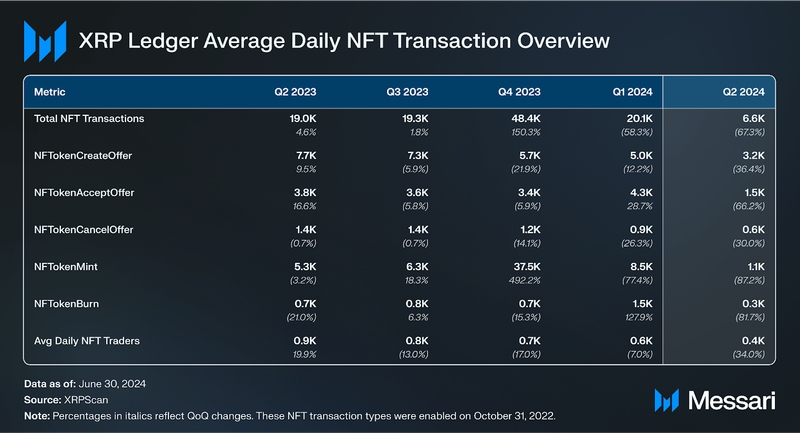
On the XRPL, NFTs are built into the core protocol and do not require smart contracts for creation or transfers, like Issued Currencies (also known as native tokens). NFTs were standardized by XLS-20 in October 2022, bringing benefits such as royalties and anti-spam features. These features help users not only avoid unwanted tokens but also help them stay legally compliant by avoiding specific tokens and smart contracts that have been made illegal within specific regions.
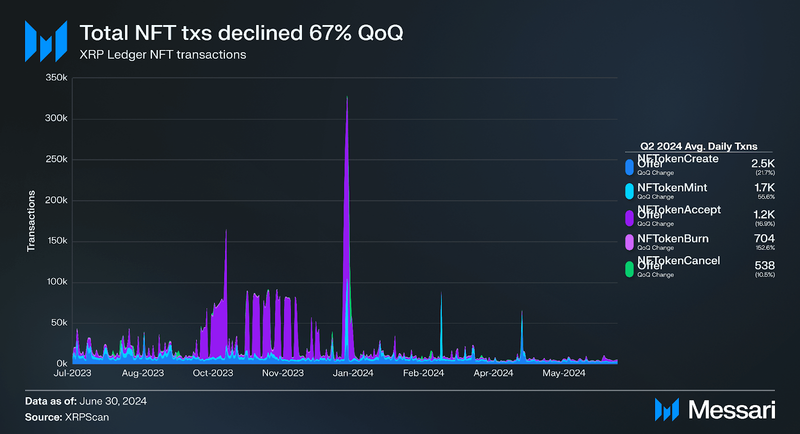
In Q2, all NFT transaction categories declined leading total NFT transactions to decline 67% QoQ. NFTokenMint transactions declined the most, falling 87.2% QoQ, while NFTokenCancelOffer transactions declined the least, falling 30% QoQ.

Massive spikes in mint activity drove NFTokenMint to surpass NFTokenCreateOffer as the most common NFT transaction type in Q4 2023 and Q1 2024. However, NFTokenCreateOffer once again became the dominant transaction type in Q2 2024. This reversal followed the trend of OfferCreate being the most dominant of all transaction types on XRPL. As of the end of Q2, 6.6 million total NFTs have been minted with the XLS-20 standard. Notably, over 3.4 million of those mints came in Q4 2023.
Notable NFT projects on XRPL include:
- Gaming NFTs such as Zerpmon, a Pokemon-esque game.
- Digital collectibles from Web2 businesses such as Ducati Motorcycles or FIFA’s World Cup League.
- Real-world solutions/assets such as Tiamonds tokenized diamonds or Xange’s carbon credits program.
In May, xrp.cafe launched its automated NFT launchpad that allows anyone to launch an NFT collection on XRPL.
SidechainsMultiple sidechains for the XRPL are either in development or were recently launched. The XRPL has stayed true to its vision of minimized L1 complexity, offering increased programmability for both general and specific use cases on sidechains.
CoreumCoreum (CORE) is an enterprise-grade L1 focused on interoperability and scalability. Coreum runs a WASM VM and is secured by a Bonded Proof-of-Stake (BPoS) consensus mechanism. CORE is used for transaction fees, staking, and validator rewards on Coreum.
Coreum was built by the Sologenic team to service user needs that could not be efficiently managed on the XRPL. The network's initial focus is on providing security tokenization, such as tokenized stocks from the NYSE and synthetic assets. In March, Coreum completed an IBC integration, granting access to all IBC-connected networks such as Cosmos Hub, Ethereum, and BSC. This was followed by:
- Integration with Picasso Network in June for IBC interoperability with Solana.
- Integration with Band Protocol’s Band Oracle for bridging RWA’s to IBC-integrated chains.
Users can already transfer between Coreum and the XRPL via the noncustodial Sologenic bridge.
XRPL EVM SidechainIn June, the Ripple team announced XRPL EVM Sidechain as the official name for Peersyst’s EVM sidechain proposal to bring smart contracts to the XRPL ecosystem. The sidechain aims to grant the XRPL ecosystem access to EVM developers and functionality, with a general-purpose scope. The sidechain is being built on the Cosmos SDK, specifically evmOS, and connects to the XRPL through the XRPL-EVM bridge. The devnet is currently live and is creating blocks every ~3.7 seconds using the Comet BFT PoS consensus mechanism, a variant of Tendermint.
The latest version of Peersyst’s EVM sidechain was deployed on devnet V2 in Q2 2023. Dapps such as identity protocol XRPDomains were deployed on the testnet. Notable additions to the latest version include:
- Support for XRP, IOU, and ERC-20 token transfers via the bridge
- Proof-of-Authority consensus
- Smart contract verification on the block explorer
Cosmos IBC interoperability was enabled in May, allowing for tokens to be bridged from IBC-enabled chains to the XRPL EVM sidechain. Additionally, the Ripple team announced in June that Axelar will replace the currently implemented bridge design proposed in the cross-chain bridges (XLS-38d) specification as the XRPL EVM Sidechain’s exclusive bridge. This will include sourcing the native gas token of the sidechain (eXRP) from the XRPL. XLS-38d was previously audited by Bishop Fox in Q3 2023, with zero critical or high-severity risks found. In a follow-on announcement, Peersyst stated the XRPL EVM Sidechain would launch following Axelar integration later this year.
The Root Network sidechain is a blockchain-based NFT system with a focus on UX and metaverse, run by Futureverse. The Root Network is live in alpha, along with its bridge to XRPL and Ethereum. Built from a Substrate fork, the Root Network uses XRP as the default gas token and has EVM support for smart contracts. The Root Network uses a delegated-Proof-of-Stake (dPoS) consensus mechanism (via the ROOT token). The protocol’s roadmap items are aligned with the XRPL, seeking to integrate the XLS-20 NFT standard and source liquidity from the XRPL DEX. Root Network also plans to offer users social recovery, management of assets, increased wallet flexibility, and a familiar Web2 experience through the account abstraction solution FuturePass.
HooksHooks is a feature to include smart contract-like functionality for the XRPL transactions. While Hooks are not Turing complete and do not enable arbitrary logic, they do allow conditions and triggers to be attached to transactions — similar to scripts on UTXO chains like Bitcoin and Cardano (pre-Alonzo). In particular, Hooks enable several programmability features, including the scheduling of payments, distributing a set percentage of funds to a creator for royalties, or imposing limits/restrictions on transactions for both volumes and counterparties.
Hooks went into a public testing and feedback period on XRPL Labs’ public testnet in Q2 2023.
GovernanceThe XRP Ledger (XRPL) utilizes an offchain governance process that allows community members and organizations to propose changes to the network. Users can submit proposals, otherwise known as Amendments, to the “XRPL-Standards” repository on the project’s GitHub. Block-producing validators on the network can then run versions of the XRPL source code that implement the proposed amendments. If 80.00% or more of the block-producing validators support the amended source code for two weeks, then it is implemented as the new source code for the network. Validators that do not support the amended source code are then blocked from contributing to consensus until they update to the newly changed version. Some notable proposals made in the second quarter of 2024 include:
- XRPL Native Lending Protocol (XLS-66): Proposal to to introduce a native lending protocol on XRPL, whereby users could lend and borrow supported assets, such as XRP, wBTC, and wETH. Unlike overcollateralized lending protocols like Aave, the protocol is intended to offer onchain fixed-term and rate loans via offchain underwriting, risk management, and an insurance fund — a model akin to that implemented by TrueFi on Ethereum.
- Sponsored Fees and Reserves (XLS-68): Would add support for an account to submit a transaction, pay the transaction fee, and/or make reserves on behalf of another account.
- Onchain Credential Support (XLS-70): Would add support for creating, accepting, and deleting credentials on XRPL as part of identity management first introduced in XRPL DID (Digital Identifier) amendment (XLS-40), which at the end of Q2 has not been enabled. If enabled,DID would provide for compliance, access control, digital signature and secure transactions use cases.
- Initial Owner Reserve Exemption (XLS-71): If implemented, it would allow newly created accounts to accept a token without initial XRP for owner reserves.
- Now undergoing voting, XLS-47d adds onchain PriceOracle object to the XRPL ledger. A blockchain oracle is a system or service that acts as a bridge between a blockchain network and the external world, providing offchain data or information to decentralized applications (dApps) on the blockchain.
In May, Ripple announced changes to the XRPL grants program including a revised screening criteria for applicants, rolling applications, the inclusion of additional XRPL-based project deveopers in the screening process, office hours for potential and rejected applicants to receive feedback, and launching a feedback survey for applicants. A grant pilot program was also rolled-out in Brazil, while the XRPL Japan and Korea Fund was also introduced drive development and innovation on the XRPL in both countries.
Additionally, the XRPL Accelerator program has two tracks in 2024: the Launch Program for early-stage projects and the Scale Program for later stage projects. In July, the first Launch Program cohort was announced, while the first Scale Program cohort of 2024 finished in June, with a second cohort set to begin in September. Other community support programs include XRPL Hackathons and the Aquarium Residency for developers offered by XRPL Commons. To date, the RippleX Bug Bounty Program has paid out nearly $1 million in bounties and covers code found in the rippled, xrpl.js, xrpl-py, and xrpl4j GitHub repositories.
Average daily transactions declined 67% QoQ from 2.8 million to 0.9 million, a return to the mean after Q1’s heightened inscription-related activity. Average daily CLOB volume also declined 40% QoQ, falling from $0.8 million to $0.5 million. Still, Q2 marked the first full quarter the AMM was available after it first launched in March, with an average daily AMM volume in Q2 of approximately $143,000 and more than $23 million in total volume.
A number of network initiatives were also proposed to bring further functionality to the XRPL, such as a native lending protocol. Likewise, the XRPL EVM Sidechain was formally announced to bring smart contracts to the XRPL ecosystem. These in-development features and supporting products are laying the groundwork for a DeFi ecosystem centered around RWAs and other tokenized assets. As newly available infrastructure like the Axelar bridge and an incoming stablecoin product serve to increase liquidity, the XRPL may see heightened network and ecosystem activity in the coming quarter.
- Home
- About Us
- Write For Us / Submit Content
- Advertising And Affiliates
- Feeds And Syndication
- Contact Us
- Login
- Privacy
All Rights Reserved. Copyright , Central Coast Communications, Inc.